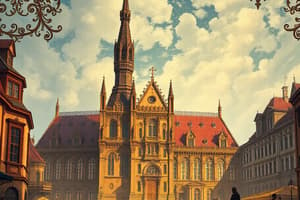Podcast
Questions and Answers
What is absolute monarchy?
What is absolute monarchy?
Absolute monarchy is a form of monarchy in which the monarch rules with unlimited power.
How does absolute monarchy differ from constitutional monarchy?
How does absolute monarchy differ from constitutional monarchy?
In absolute monarchy, the king or queen has unrestricted power, while in constitutional monarchy, their authority is limited by the constitution or other governing bodies.
What led to the emergence of absolute monarchy in Europe?
What led to the emergence of absolute monarchy in Europe?
Absolute monarchy emerged in Europe as a response by monarchs to the social upheaval caused by the Black Death and Renaissance.
Which territories served as models for the spread of absolute monarchy?
Which territories served as models for the spread of absolute monarchy?
What were the counter-balancing forces that absolute monarchy aimed to centralize?
What were the counter-balancing forces that absolute monarchy aimed to centralize?
Flashcards are hidden until you start studying
Study Notes
Absolute Monarchy
- A system of government where the monarch holds complete control and authority over the government and people
Differences between Absolute and Constitutional Monarchy
- In absolute monarchy, the monarch's power is unrestricted and unchecked, whereas in constitutional monarchy, the monarch's power is limited by a constitution or laws
- Absolute monarchy is characterized by the absence of separation of powers, whereas constitutional monarchy has a system of checks and balances
Emergence of Absolute Monarchy in Europe
- The rise of absolute monarchy in Europe was facilitated by the decline of feudalism and the growth of centralized states
- The emergence of absolute monarchy was also influenced by the Catholic Church's doctrine of divine right, which held that monarchs were appointed by God and accountable only to Him
Models for the Spread of Absolute Monarchy
- The territories of France, Spain, and Prussia served as models for the spread of absolute monarchy in Europe
- These territories were characterized by strong, centralized governments and a powerful monarch
Counter-balancing Forces
- Absolute monarchy aimed to centralize power by eliminating or controlling counter-balancing forces such as the nobility, the church, and regional assemblies
- The monarch's power was also challenged by the rise of a powerful bureaucracy and the emergence of a middle class
Studying That Suits You
Use AI to generate personalized quizzes and flashcards to suit your learning preferences.




